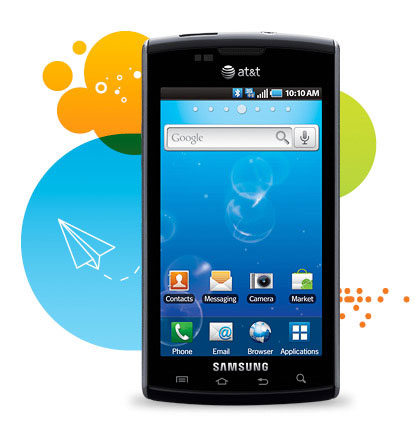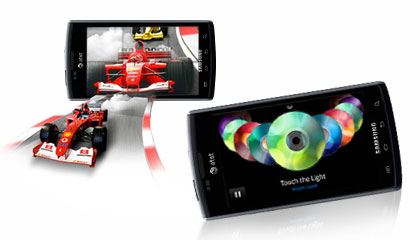Introduction

Guy walks into an AT&T store and says, “I want a touch-screen smartphone, but I’m concerned about the iPhone 4 antenna issues.” Until the Samsung Galaxy S Captivate, AT&T sales staffers could only perform stuttering a Ralph Kramden prevarication. But will iPhone purchasers or returners be captivated by the Captivate’s capabilities? It’s a more social-network-centric device than iPhone, with a large 4-inch, crisp “super” AMOLED screen. While it suffers in a basic features comparison with iPhone, that’s also like arguing that U2 sucks because they haven’t sold as many records as The Beatles.
Features and Design
A slimming black slab superphone, Samsung’s Captivate contains nearly all the modern cell Android 2.1 amenities: 7.2 Mbps 3G connectivity, WiFi, a speedy 1GHz Hummingbird processor, 5-megapuxel camera and HD (720p resolution, 30 fps) video recorder, Bluetooth 3.0, six-axis sensor for enhanced gaming, 16GB internal memory, and SWYPE text input. Captivate also includes something Samsung calls “Social Hub,” which aggregate updates from your Facebook, Twitter and MySpace accounts.The Captivate’s main physical advantage over the iPhone is its screen. It’s a 4-inch super AMOLED display, compared to the iPhone’s 3.5-inch LCD display. The Captivate displays brighter, more accurate colors than the iPhone; For instance, the red band on ESPN’s home page is actually red, as opposed to the nearly maroon rendering on the iPhone. However, the Captivate’s whites tend toward the blue, and the iPhone’s screen is generally brighter, especially out in the sun. With its 960 x 640 pixel Retina resolution, reading text on the iPhone 4 is also easier on the eyes. But you’d only notice the brightness and readability differences in a side-by-side comparison, and neither is a deal breaker.
The curvier Captivate is around a quarter-inch taller and wider than the iPhone, and barely perceptively thicker. None of this makes much real-world difference, especially considering the extra half-inch of screen real estate. Its rear resembles the old Sidekick. Even though it’s slightly bigger, the Captivate’s all-plastic housing makes it a surprisingly noticeable 0.3 ounces lighter than the iPhone 4.
To the left of the earpiece are two small windows: These are light sensors, not a front-facing camera array, which the Captivate surprisingly lacks.
One other annoying drawback is the backlighting on the front touch control, such as menu, home, back, and search. The touch control backlighting goes off while the display is still on, rendering them nearly invisible in artificial light. We often had to touch the area twice, once just to activate the backlight so we could see where the controls were. This became increasingly frustrating the longer we played with the Captivate, and almost became a deal breaker.
There are only two physical controls: the volume rocker on the left side, and the power switch on the right, which doubles as a lock and hold key in certain apps.
The microUSB jack is at the top, next to the headphone jack, which makes it less awkward to use the phone when it’s plugged into a PC for charging and syncing.
Multimedia

AT&T has crammed Captivate with video options, including the oddly not-yet-renamed Cingular Video (it’s called “Mobile Video,” but connects to a Cingular Video URL), the subscription-based MobiTV (you get a free trial period), and the yet-to-be-implemented Samsung Media Hub, from which you’ll be able to rent or buy movies and TV shows. Unfortunately, most the low-res offerings from these services don’t exactly challenge the AMOLED screen.
Like most 3G phones, YouTube videos default play in standard resolution, requiring you to drill through the menu to get the high-quality version that helps show off the AMOLED technology.
Samsung also has included a media app called AllShare, which lets you play a file from your phone on another media player, play a file from a server on the phone, or play a file from a server onto another player, using the phone as a remote – all requiring Wi-Fi and DLNA.
The bulk of the audio emanates from a rear speaker, which produces plenty of volume. But be careful where you put your hand, or you’ll muffle the sound.
via digitaltrend
No comments:
Post a Comment